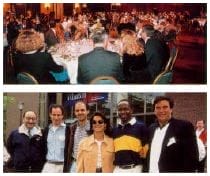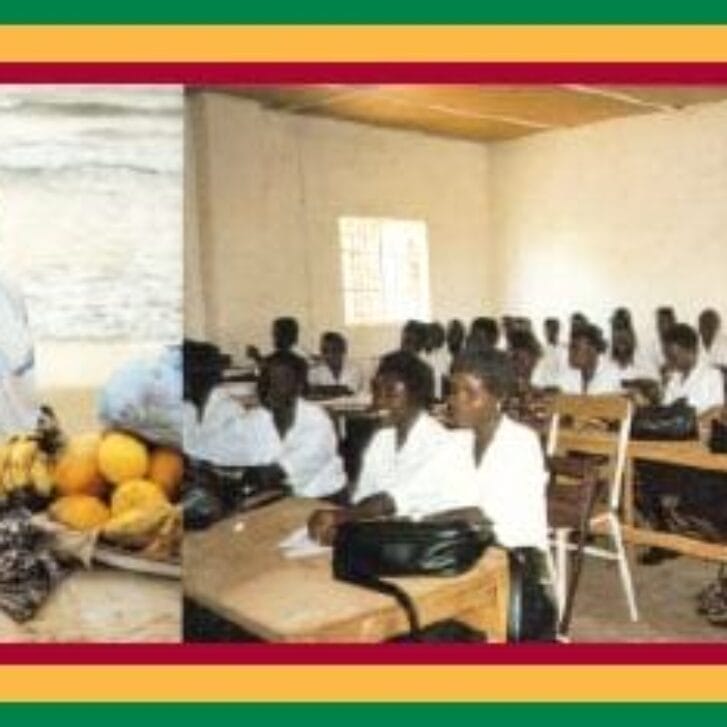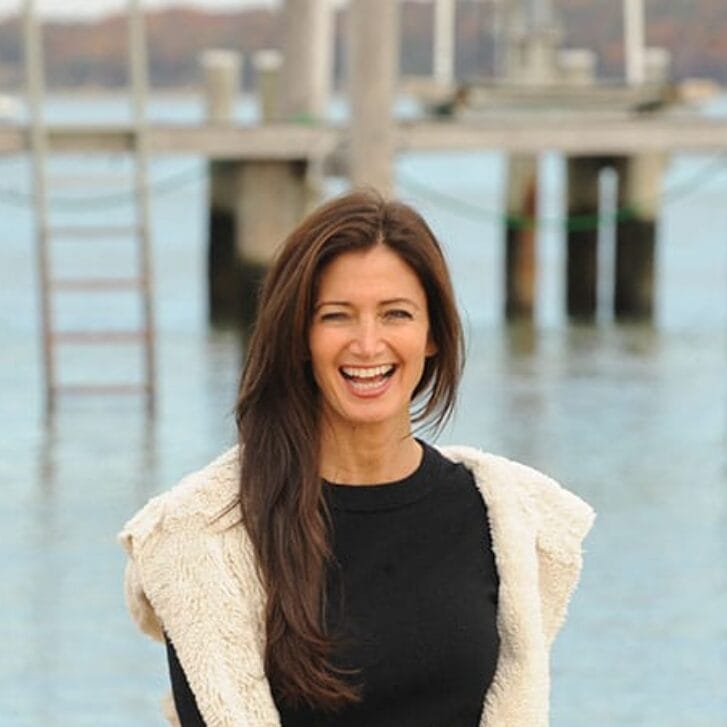A small white-haired woman clasped the arm of her newly-graduated grandson as they left Wharton’s MBA commencement ceremonies on Sunday, May 18. “Let me know when you get your e-mail address,” she said. “I want to be sure to keep in touch.”
 Graduation was the culmination of Wharton’s 1997 Reunion Weekend — a three-day series of events on May 16, 17 and 18 that reinforced Wharton’s sense of community and offered participants many opportunities to “keep in touch.”
Graduation was the culmination of Wharton’s 1997 Reunion Weekend — a three-day series of events on May 16, 17 and 18 that reinforced Wharton’s sense of community and offered participants many opportunities to “keep in touch.”
Executive education sessions focused on “Stocks or Bonds — Where Do We Stand Now?” and “Developing Your Leadership.” An alumni/faculty exchange discussed “Managed Care: Coping with the Counterrevolution.” Seminars brought alumni up to date on “Learning Technologies of the ‘90s” and “Career Transition — Utilizing Wharton’s Resources.” And MBA students from this year’s graduating class presented plans for start-up companies in “The Wharton Laboratory — Seeds of Entrepreneurship.”
Woven throughout the weekend were receptions, picnics, brunches and dinners as more than 500 members and guests from the Reunion Year classes of 1967, ‘72, ‘77, ‘82, ‘87 and ‘92 networked, socialized and marched in the Penn parade. On these pages we highlight some of the events of Reunion Weekend and profile six Reunion year graduates.
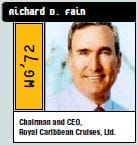
Richard Fain’s biggest challenge over the next few years is “communicating to the 93 percent of Americans who have never been on a cruise just what they are missing and why they can afford it.”
It’s a message that Fain and Miami-based Royal Caribbean Cruises, Ltd. are taking giant steps to deliver. In April, the $1.4 billion company launched its 11th ship, the 2,000-passenger Rhapsody of the Seas, bringing its total number of berths to 16,000. Approximately $3 billion has been set aside for four more ships over the next three years.
That kind of mega-investment suggests a certain optimism on Fain’s part, not to mention enthusiasm for the value of his product. “A lot of people are still under the misconception that cruises are for older, wealthier people,” Fain says. “In fact, the average age of our passenger is less than 45 and the target annual family income is $35,000.”
Since he was named chairman and CEO in 1988, Fain’s strategy for Royal Caribbean has indeed been “megabrand.” The word, he says, refers not only to the company’s presence within the travel industry but also to the global nature of its itineraries — 154 destinations around the world — and the size and scope of its ships.
Smaller Caribbean-based cruise ships have been shouldered aside over the past few years by larger world wide-based ships that come with seven-deck atriums, cabins with verandas, state-of-the-art theaters, casinos, piano bars, children’s areas, two-deck dining rooms, small cafes, outdoor pools, libraries, conference centers, spas and shopping malls.
Offshore, the amenities continue. Royal Caribbean, which went public in 1993, currently operates two private islands in the Bahamas and off the north coast of Haiti for its cruise ship passengers.
As part of its expansion strategy, Royal Caribbean has chosen to run onboard operations that previously were contracted out, including casinos, gift shops and, most recently, wedding parties. “We typically have conducted about one wedding service per cruise, but now we are prepared to organize the whole event,” Fain says. The idea apparently appeals to the matrimonially-inclined. “Even before we could announce this initiative publicly,” Fain notes, “we received 40 inquiries.”
Royal Caribbean’s biggest competition, he adds, comes from land-based vacations, “even though a cruise offers more variety and choice of activities than other comparable vacations and it’s less expensive when you consider that the cost includes all travel, food and entertainment.”
And for those worried about every lurch and roll of the seven decks: “Ships these days are so huge that getting seasick is no longer an issue,” Fain says. “If you were in New York harbor, as I recently was with our newest ship, sitting on the observation lounge of the top deck, you could look the Statue of Liberty in the eye. That is how large and stable today’s cruise ships are.”
Fain was born in Boston, brought up in Providence, R.I., and graduated from the University of California-Berkeley. He worked at Wells Fargo Bank, attended Wharton and then took a job with I.U. International Corp.
In 1975, he went to work for an I.U. subsidiary in London called Gotaas-Larsen Shipping Corp., first as treasurer and later as joint managing director. Gotaas-Larsen was a minority shareholder in Royal Caribbean. In 1988 the majority stockholders of Royal Caribbean offered Fain the job of chairman and CEO.
Fain estimates he has probably gone on about 20 “complete” cruises in his life, not counting the many times he has flown to port of call and spent two days with the ship’s passengers and officers. His favorite cruise destination? “My favorite destination,” he says, “is always the ship.”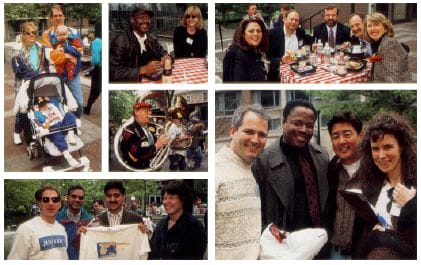
 Anyone who thinks that launching a new product is an intuitive, relatively effortless and usually successful process should think again. By most industry estimates, says Sharon Fordham, president of LifeSavers, only 10 to 15 percent of new products succeed.
Anyone who thinks that launching a new product is an intuitive, relatively effortless and usually successful process should think again. By most industry estimates, says Sharon Fordham, president of LifeSavers, only 10 to 15 percent of new products succeed.
“I believe that figure is accurate because in many companies the whole process tends to be random,” she notes. “People often sit around and brainstorm ideas and then follow whichever one sounds best.”
Fordham does it differently — and with the kind of success that has earned her awards, promotions and media attention, not to mention very satisfied consumers. At Nabisco, which she joined in 1981, her best sellers include Ritz Bits TM and Teddy Grahams TM, Mr. Phipps TM pretzel chips and SnackWell’s TM reduced fat and fat free cookies and crackers. Now as president of LifeSavers, a Nabisco subsidiary, she has to her credit the breath-freshening hit gum Ice Breakers TM and a line of popular low-fat SnackWell’s chocolates.
Ice Breakers, Fordham is quick to add, was already in the pipeline when she arrived at LifeSavers two years ago. “What I did was contribute the resources to it and also the understanding that it was a much bigger idea than the company thought. Championing the right new product is every bit as important as developing new ideas.”
Back to new products. “Our process starts with a view of what our business is,” Fordham says. “We look at similar products, at how consumers use these products and at the products’ physical attributes.”
Fordham’s approach also analyzes current trends in the food industry, successful vs. unsuccessful products, neighboring food categories and, perhaps most importantly, gaps in consumer usage.
At some point the group begins to agree on strategic thrusts for the new product which then kicks off a series of brainstorming sessions to come up with specific ideas. And yes, there is some magic to the whole operation, although “I don’t think that new product development is as magical or as intuitive as most industry observers would believe,” says Fordham. “It’s a structured process that relies on teamwork, strategic direction and a thorough understanding of your industry, your consumers and your competitors.”
An appreciation of the end result helps. “It’s a great honor to manage a product like Life Savers TM which are really a national icon,” says Fordham, noting that the first Life Savers candy was rolled out in 1912. At the same time, Fordham hasn’t hesitated to make changes. One of her first moves after coming to company headquarters in Parsippany, N.J., was to add three extra Life Savers to the package, without raising the price.
The strategy worked. “We did take a minor margin hit in order to extend the length of the roll, but the extra sales volume has made it more than pay off,” she notes. Sales of the LifeSavers division itself are expected to hit $600 million this year, 10 percent higher than 1996.
Fordham’s big challenge now is to zero in on the gum business, which means taking a fresh look at Care*Free TM, aimed at adult women, and Bubble Yum TM, targeted to teens. “We have identified some opportunities for repositioning Care*Free, including using the slogan ‘Care*Free gum will shine your smile,’” says Fordham. “That’s a very compelling promise. To go along with this we will have new packaging, new advertising and major promotions.”
Fordham grew up in Somerset, N.J., where her ambition throughout high school was to someday play the clarinet for a world-class orchestra. Instead, after graduating from Rutgers and rethinking the life of a professional musician, she attended Wharton, majored in marketing, and worked at Bristol-Meyers and Borden before joining Nabisco. While at Nabisco, she held several positions, including group product manager, cookies; director of marketing, crackers; senior director, new products, and vice president, new business.
Eight years ago, she discovered yet another talent. “I had signed up for a tennis tournament at a sales outing in California, but the weather was too hot to play. One of my friends persuaded me to join a golf foursome even though I had never held a golf club. Our team won the tournament and I won the ladies’ prize for longest drive. Three months later I hit my first hole in one. I knew this was the game for me…”
It isn’t just the sheer enjoyment of hitting the ball that delights Fordham. “I have been amazed at the relationships I have been able to build and the contacts I have made, especially among older executives. It’s been tremendously powerful in building my career… My goal now is to play the top 10 golf courses in the world.”
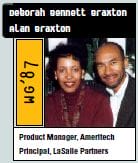 Deborah Bennett Braxton remembers sitting in macroeconomics class during her second year at Wharton becoming increasingly irritated at a noisy student behind her. She turned around and told him to be quiet.
Deborah Bennett Braxton remembers sitting in macroeconomics class during her second year at Wharton becoming increasingly irritated at a noisy student behind her. She turned around and told him to be quiet.
“He kept on talking,” Bennett says, but the connection was made. Deborah and Alan Braxton both took jobs with Quaker Oats after graduation. In 1989, Deborah moved to Los Angeles to work for Kal Kan Industries. Alan followed and landed a job at LaSalle Partners. The two were married in 1990. Last September, when Deborah was working at Kentucky Fried Chicken, Alan was transferred from LaSalle Partners’ L.A. office to its headquarters in Chicago. For Deborah it meant finding a new job.
She chose telecommunications, because “it’s a hot industry, it’s growing and there are lots of opportunities,” she says. As a product manager for Chicago-based Ameritech, a $15 billion former Regional Bell Operating Company (RBOC), Braxton is responsible for identifying new telephone technology for a five-state region. “Ameritech offers services like call waiting, caller ID and three-way calling — i.e.,network services. But they aren’t appealing if you don’t have equipment to access them. In the residential area I manage the process of identifying suppliers for equipment such as corded, cordless and the new-tech 900 megahertz models (a subset of cordless). That includes negotiating the cost of goods, setting purchase terms, forecasting availability, identifying new products and overseeing quality assurance and testing processes.
“Right now, I’m evaluating screen phone technology that allows consumers to access e-mail and the Internet and eventually will allow them to conduct transactions, such as retail purchases, home banking and smartcards. The possibilities are endless.”
Braxton grew up in Hempstead, Long Island, and graduated from Dartmouth. She spent four years at Mobil Chemical Corp. in Michigan before coming to Wharton. The Braxtons live in Oak Park with their two children, ages 4 and 1.
Alan Braxton is a principal at La-Salle Advisors, the real estate investment management arm of LaSalle Partners, and is responsible for marketing the company in the Midwest and Southeast regions.
His clients include public and corporate pension plans, endowments and foundations. “Real estate as an asset class is in a high growth period because of strong supply and demand fundamentals and increasing capital flows,” says Braxton, who spends about 60 percent of his time on the road. “The market has picked up significantly since the early ‘90s, and that growth is expected to continue over the next five years.”
LaSalle Partners has corporate offices in 17 U.S. cities and London, Paris, Mexico City and Beijing. LaSalle Advisors is one of the largest real estate investment companies in the U.S., with approximately $15 billion under management.
“One of the biggest challenges of this job is the number of new products being offered and the increasing amount of information that I need to be on top of, including information on real estate investment trusts (REITS) and private placements,” says Braxton, noting that LaSalle Advisors manages more than $2 billion in its REIT portfolio alone. “REITs are currently the highest-growth area in the industry.”
 Jeffrey Miller began his catering career when he was a sophomore at Wharton by offering “brunch in bed” to students in the high rise dormitories. “It was part of an independent study project for a class in entrepreneurial management,” Miller says, “but then I kept doing it junior and senior year as well. Pretty soon I was being asked to cater fraternity brunches, then cocktail parties and then faculty lunches. When [former Penn President Sheldon] Hackney came to campus, I sent him a chocolate cake. A few days later his wife asked me to cater a dinner they were having for Art Buchwald.”
Jeffrey Miller began his catering career when he was a sophomore at Wharton by offering “brunch in bed” to students in the high rise dormitories. “It was part of an independent study project for a class in entrepreneurial management,” Miller says, “but then I kept doing it junior and senior year as well. Pretty soon I was being asked to cater fraternity brunches, then cocktail parties and then faculty lunches. When [former Penn President Sheldon] Hackney came to campus, I sent him a chocolate cake. A few days later his wife asked me to cater a dinner they were having for Art Buchwald.”
Miller now employs 30 full-time people, works out of an office in downtown Philadelphia, manages a 7,000-ft warehouse/kitchen in the suburbs and expects to do $1.6 million in sales this year.
More importantly, he still likes to cook — a skill he learned during short internships in restaurants like New York’s Le Cirque, Paris’s Le Moulin de Mougins and London’s Simpsons in the Strand. His favorite dish to make is one he invented himself: steamed salmon with black bean buerre blanc.
“When I was an undergrad I sent a letter to William Fishman, the founder of ARA, and asked if I could meet with him,” says Miller. “We talked for about an hour, and at one point I asked him the secret of his success. His response was: ‘I try to find the best people I can and then I try to keep them happy.’ ‘Is that it?’ I asked him. It sounded so simple. Since then, I have found out that it’s actually the hardest part of running a business …”
An important part of Miller’s undergraduate experience turned out to be a course that he taught on pastry making. A 19-year-old classmate named Laurie Magid signed up. “I learned how to make Napoleons,” says Magid, but more importantly, she introduced herself to the chef and invited him to a party. Magid went on to law school at Columbia and returned to Philadelphia in 1985 to clerk for one year on the Third Circuit Court of Appeals. She and Miller were married in 1986.
Magid spent the next eight years in the Philadelphia District Attorney’s office doing primarily appellate work. “Although the DA’s office is mostly criminal work, the first case I was assigned was a civil case — prison overcrowding. The suit was filed in 1982 and it’s still going strong,” she says.
She left the DA’s office in 1995 for a full-time position at Widener Law School in Chester, Pa., where she teaches classes on criminal procedure and legal research and is co-director of the legal writing program. That same year she was appointed by Governor Thomas Ridge to the Pennsylvania Commission on Sentencing.
“I don’t cook much,” Magid adds. “But I cook well … I tend to make ‘homier’ things than Jeffrey. My spaghetti sauce is better than his, and so are my chocolate chip cookies. But he can do things that require technique — like croissants.”
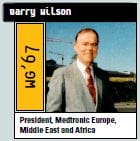 One way to look at Barry Wilson’s decision early last year to move Medtronic’s European headquarters from Brussels, Belgium to Lausanne, Switzerland would be to ask yourself the question: If you had to wear a pacemaker, where would you want this tiny (25 gram) device to be manufactured?
One way to look at Barry Wilson’s decision early last year to move Medtronic’s European headquarters from Brussels, Belgium to Lausanne, Switzerland would be to ask yourself the question: If you had to wear a pacemaker, where would you want this tiny (25 gram) device to be manufactured?
Wilson’s answer had a lot to do not just with Switzerland’s highly sophisticated micro machining industry (as in watches and clocks) but also with the country’s infrastructure of renowned technical institutes, world-class medical facilities and cutting-edge health care equipment.
Minneapolis-based Medtronic, with revenues of $2.5 billion, is the number one medical device company in the world. It manufactures everything from pacemakers and implantable defibrillators (small devices half the size of a cigarette box that return a rapidly beating heart to a normal rhythm) to tiny stents that prop open diseased arteries and neurostimulators that lessen the involuntary trembling associated with Parkinson’s Disease. As Wilson says, “our potential is limited only by health care budgets and our ability to get the products out.”
Wilson heads up Medtronic’s European, Middle Eastern and African markets which together bring in annual revenues of $750 million.
The relocation to Lausanne was prompted in part by the Clinton administration’s decision to repeal Section 936 of the U.S. tax code which granted special tax breaks to companies with manufacturing operations in Puerto Rico. The repeal meant that Medtronic, which had two manufacturing operations in southwest and south central Puerto Rico, was facing the prospect of significantly higher taxes.
Wilson looked at countries around the world, including China and Ireland, before settling on Switzerland. He is relocating not only much of Medtronic Europe’s manufacturing operations, but also its headquarters and research staff and is establishing a second education center. “Costs are higher, but so is productivity, and social costs are low,” says Wilson. For example, whereas benefits cost Dutch companies an additional 50 percent of an employee’s base salary, that figure is only 25 percent in Switzerland.
Europe’s upcoming move to a single currency (the ecu) has both “good and worrisome aspects,” Wilson adds. “It’s good in that it will make trading a lot easier and more attractive … A number of health care companies are moving towards centralized distribution in Europe as transportation continues to improve. We already have a centralized distribution system, but we will be moving towards centralized billing as well. All charges will be in ecus and there will be a single collection point. Foreign exchange transaction costs will no longer exist.”
On the worrisome side, “there is no common pricing in Europe. If you convert products in many industries to a common currency you will find huge variation in the finished price once you include the valued added tax, the retail markup and the social charges — which vary according to the area. Such price differences have been largely masked by different currencies, but they won’t be once the ecu is adopted. Companies then could have to justify these differences in order to avoid ‘price adjustments.’”
Before joining Medtronic, Wilson was with the American Cyanamid Co. as president of the Lederle International Division in Wayne, N.J. Prior to that he was president of Bristol-Myers Squibb, Europe.
“All of the new technologies start in Europe, where the clinical trials can be done much more quickly than in the U.S.,” says Wilson. “At the same time, we have proven that medical devices tend to be better alternatives than drugs for treatment of many medical conditions. The defibrillator, for example, is safer and less expensive over the long term than drugs, and it has no side effects. For heart patients, it’s like having a lifeboat with you at all times.”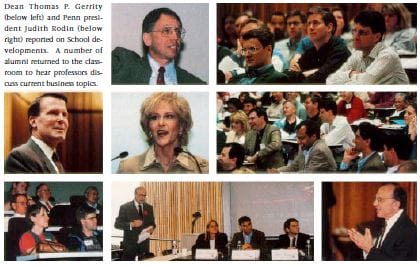
 During his childhood in Puerto Rico, Carlos Alicea was glued to the television set whenever the Casals music festival was in town. He went on to attend a local high school for the performing arts — half of each day’s curriculum was devoted to music studies — and then Indiana University School of Music in Bloomington.
During his childhood in Puerto Rico, Carlos Alicea was glued to the television set whenever the Casals music festival was in town. He went on to attend a local high school for the performing arts — half of each day’s curriculum was devoted to music studies — and then Indiana University School of Music in Bloomington.
After graduating he toured the U.S. and abroad playing trombone with a chamber music group before moving back to Puerto Rico where he spent five years as general manager of Puerto Rico’s symphony orchestra. Two years later he earned his MBA from Wharton.
All of which prepared Alicea well for his current position as head of marketing for Latin America for BMG Classics, a division of BMG Entertainment that is geared towards the adult consumer. Over the past four years, BMG Classics has diversified into repertoires that include classical, jazz, New Age, crossover, world music, Broadway scores and movie soundtracks.
Although Alicea works in BMG Classics’ New York headquarters, he is on the road 50 percent of the time. “We focus mainly on Argentina, Brazil, Chile and Mexico but we are also in Colombia and Venezuela,” says Alicea, who worked for Procter & Gamble before joining BMG in 1993. In addition, Alicea is in charge of several U.S. projects, including recent recordings of Michael Tilson Thomas and the San Francisco Symphony Orchestra.
In Latin America, Alicea’s initiatives involve: managing, marketing and selling jazz artists such as Dizzie Gillespie and Tommy Dorsey; recording classical pianist David Helfgott, who is the subject of the movie Shine, playing Rachmaninoff’s Third Concerto; marketing soundtracks from Broadway shows like “Chicago” and movies like Independence Day; and offering a recording of the Grammy award-winning Irish group “The Chieftains”.
The most popular U.S. export to Latin America? The soundtrack from Star Wars. Says Alicea: “It shows how cultural barriers can be transcended.”
BMG Classics’ main avenue of distribution is through the retail chains. The company recently launched a campaign in Spanish and Portuguese to sell the “Greatest Hits” line of more than 20 classical and jazz recordings made in the past five years in the U.S.
“The purpose is to develop a future audience, to educate consumers about music and make it accessible to them,” says Alicea. “We include a free booklet with purchase that is a guide to both the classical and jazz side. It gives consumers basic ideas on how to start building up a music library of their own.”




















